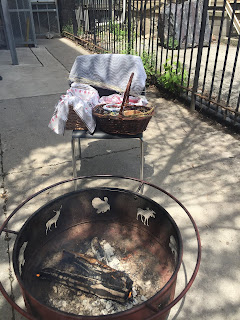There's another line in the anthem that bothers me: "My home and native land." However long I live in Canada it will never be my native land and it's the same for quite a few of us. In Toronto, over 50% of residents were born outside of Canada; even if we become citizens, it still won't be our native land.
The former prime minister, Stephen Harper (odious man) made a comment some years ago about health-care benefits for refugees. He said, "We do not offer them a better health-care plan than the ordinary Canadian can receive. I think that's something that both new and existing and old-stock Canadians can agree with." The 'Old Stock' epithet blew up around him-- as he deserved. A commentator referred to his choice of words as a political 'dog whistle', a signal audible only to those attuned to that register. In this case, though, it backfired and he drew (well-earned, it seems) accusations of racism and manipulative identity politics.
The man was soon out of office (toppled by Trudeau) but those words rattle on. A Canadian playwright, Hannah Moscovitch, wrote a play called "Old Stock: A Refugee Love Story" about Jews fleeing to Canada from brutal pogroms in Romania early in the 20th century (about the same time my grandparents reached Ellis Island escaping pogroms in the Ukraine). Two weeks ago, husband, daughter, and I saw the production at Toronto's Tarragon Theatre and loved it.
But in truth, the 'old stock' Canadians (and Americans) are the indigenous populations. Canada does a better job of acknowledging both their existence and the crimes committed against them by the hordes of invaders. Yesterday, as part of the annual celebration of Doors Open Toronto, I got to visit the Native Women's Resource Centre of Toronto, a building I've cycled past numerous times. This time I parked my bike in the scruffy urban park across the street, shoved my helmet and reflective gear in a shopping bag, and went into the cool old dark converted house. High ceilings, polished wood, a long straight flight of white-painted stairs ascending. A man with a pony-tail greeted me and showed me how to smudge by burning one of the four sacred medicines in a container and bringing the smoke to my face. He chose tobacco for me and lit it in an abalone shell.
 |
| Native Women's Resource Centre of Toronto |
"I do. Is that Ojibwe?" It is. The plural, he explains, is moccasinnan. We look at the program display, a whiteboard neatly divided into 31 squares with bright pink duct tape. The array of offerings intrigues me; there are several in which I would enroll. In addition to Ojibwe, there is beading, 'shopping math', computers, Liberty Moves, indigenous baby-food making, full moon ceremony, drum circle, 'red embers' (here's last month's). I ask about 'red embers' (having figured out from context that Liberty Moves is an exercise class), and it turns out to be a program linked to the Red Dresses, hung from trees to memorialize the many, way too many, missing and murdered Indigenous women across Canada.
On a nearby table are paper cups and jugs containing cedar tea and strawberry water. I sample both. My guide points me to the back of the building, to a small quiet outdoor enclosure. "You can see our sacred fire."
The fire is burning in a metal cauldron standing on three legs. There are low flames and a floating cloud of fragrant smoke; a group of four or five Spanish-speaking women lean over and take pictures. I edge around to the less-smoky side and sit by a couple of volunteers, one of whom has just lodged his small axe in a log on the ground. He identifies himself as the sacred fire-maker.
I admire the cauldron and ask if I might take a photo.
"Sure."
"I wondered whether you'd say yes," the other volunteer tells him.
"Well, this time I think it's okay."
The volunteer and I both ask when it wouldn't be; the fire-maker says, "When it's for a specific ceremony, like full moon."
I wonder aloud where the cauldron comes from, because the cut-out animal shapes in the metal are beautifully decorative. The fire-maker and the volunteer shrug and ask another volunteer who has been chatting with the Spanish-speakers. "I think I got it online. Maybe Canadian Tire," she laughs.
"Is it okay for me to burn some of the medicine?" I ask. Yes, they all say together, please do.
"Remember to hold it and put your thoughts into each pinch before burning it," the first volunteer says, and I give it a try: a pinch of tobacco, a pinch of white sage, one of cedar, a few strands of sweetgrass, my good thoughts.
I leave feeling oddly peaceful. These particular oldest-stock Canadians have created an oasis amid the occupation.
 |
| Employment office next door |

No comments:
Post a Comment